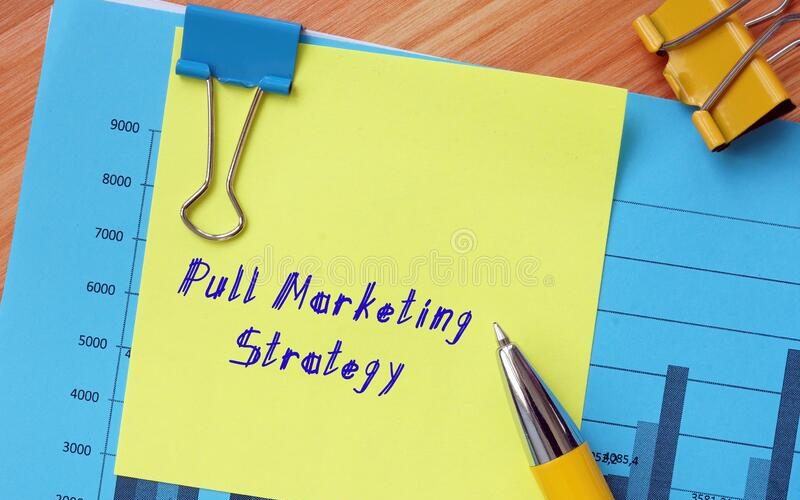Running an online business necessitates a decision between two fundamental concepts that will guide your marketing strategy. It is usual (and critical) to balance your budget, time, and efforts on building your business across organic and paid techniques that produce the best outcomes. Choosing a marketing strategy based on push or pull. We examined the push marketing strategy in our last piece, so in this article, we’ll look at the pull marketing strategy and their examples.
What is a Pull Marketing Strategy?
A pull marketing strategy, also known as a pull promotional strategy, is one in which a company tries to generate demand for its products by drawing (“pulling”) consumers to the product. Pull marketing methods are based on persuading customers to want a specific product. A pull marketing strategy can be employed independently or in tandem with a push marketing strategy.
Origin of the Pull Marketing Strategy
To comprehend the pull strategy in Marketing, we must first understand its origins. During the industrial revolution, the most frequent marketing concept was the production notion. Industries created commodities for consumption, which were then disseminated in the market. The demand exceeded the supply. As a result, it was all about manufacturing rather than sales or marketing.
So, as information spread and new industries sprang up, it became clear that customers now had more options. As a result, simply manufacturing the goods was insufficient to meet the needs of the consumers. Supply gradually began to meet and even exceed demand.
Customers had a lot of options, and that is when most businesses began pushing their products to them. Soaps, books, and washing machines were all sold door to door, and there was a lot of hard selling. It was a push strategy that was being used.
However, consumers progressed beyond that stage, and businesses realized that a customer will not buy a product until and until he wants it. Unless and until the product possesses qualities and attributes that the buyer desires.
That is when businesses began to pull and attract customers to themselves. The Pull strategy was named after this clever action, which drew the customer to the company’s doorway.
The purpose of a pull marketing strategy is to persuade a consumer to actively seek out a product and to get merchants to carry the product in response to direct consumer demand.
Methods for Implementing a Pull Marketing Strategy
A company uses a pull marketing strategy to advertise its goods directly to consumers. The products are then sought for by the consumers. Today, various pull marketing tactics are accessible, including:
- Social Media Networks
- People’s recommendations
- Media Coverage
- Discounts and sales promotions
- Advertising
- Email Marketing
An Example of a Pull Marketing Strategy
The following is an example of a pull marketing strategy:
A pull marketing strategy entails a company conducting marketing operations to attract customers to its products.
For example, a production business may undertake direct marketing campaigns to consumers. Consumers seek a specific product as a result of marketing campaigns and go to stores to acquire the product. Retailers then contact the manufacturer to stock the goods and respond to direct consumer demand.
A pull marketing strategy differs from a push marketing strategy, which employs marketing efforts across the supply chain.
Pull Marketing Strategy Examples
#1. Social Media Marketing
Except for social media paid commercials, which are discussed in the push strategy, there are a variety of ways to use social media marketing as a kind of pull marketing. This includes how-to videos, influencer content (for example, an influencer offering a demo of how they use your product), stunning photographs and videos of your product, and social media co-marketing campaigns.
#2. Search engine optimization
Search engine optimization (SEO) is a strategy for getting your content, web pages, and other assets in front of individuals who are looking for relevant keywords, phrases, and terms.
Your marketing materials and web pages will surface in front of your target audience organically if you optimize your web pages and other content for the search terms they are actively looking for. This is an excellent approach to get in front of your target demographic and buyer prospects without sounding aggressive, while also improving brand awareness.
#3. Web Blogs
Blogging is an efficient way to educate your target audience and provide them with the knowledge they need to make informed purchasing decisions, learn how to utilize and apply your product or service, or receive insight into industry changes, product upgrades, and so on.
When you search engine optimize your blog material, it appears in front of your target audience organically on search engines like Google, boosting the number of people who see and interact with your content while also raising brand awareness and other factors.
Advantages
A pull marketing strategy has various advantages:
- Capable of establishing direct contact with customers and fostering customer loyalty
- Increased bargaining power with retailers and distributors
- Concentrates on increasing brand equity and product value.
- Consumers voluntarily seek out the goods, which alleviates much of the strain associated with outbound marketing.
- Can be used to assess a product’s market acceptance and collect consumer input on the product.
Disadvantages
The following are some of the potential drawbacks of utilizing a pull strategy:
- Only works well when there is a significant level of brand loyalty.
- The lead time is long because buyers compare alternatives before making a purchase.
- It is necessary to generate strong demand for a product, which can be tough in a highly competitive market landscape.
- Strong marketing efforts are required to persuade consumers to actively seek out the goods (they may, instead, just decide to settle for whatever similar product a retailer has in stock, rather than insisting on getting your product)
Push Marketing Strategy vs. Pull Marketing Strategy
Push marketing, also known as outbound marketing, can result in faster sales since it is powered by what you push out to your audience through your marketing. Pull marketing, also known as inbound marketing, begins internally and focuses on developing and refining a marketable brand for new and existing clients.
Is push or pull marketing more effective?
Consider how you want to approach customers when deciding which tactic is ideal for your company.
If you want to spread the word about your company, a push is most certainly the way to go. If you’re a marketer looking to create brand awareness in your industry, possibly for a specific product or service, pull is usually the greatest option.
Push marketing has a few drawbacks, most notably sharing costs and retaining long-term clients. If your company collaborates with a supplier to implement a push marketing strategy, you will have to split profits with the supplier, which means less revenue for you. Building brand loyalty is tough with an outbound strategy because push marketing focuses on short-term sales.
Meanwhile, one disadvantage of pull marketing is that you may not be catering to the proper target group. To connect with your customers, you must first understand who they are and what they are searching for. For example, an athlete looking for running shoes may be uninterested in marketing for heels.
Implementing a push and pull marketing strategy is a great method to ensure you’re covering all bases with your marketing strategy – you can marry the best components of both tactics in a way that’s complementary to your brand, audience, and goals.
Advantages of Using Pull Marketing Strategies Over Push Marketing Strategies
There are numerous advantages to utilizing a pull strategy over a push strategy.
#1. Value creation
Because the company prefers to employ pull marketing rather than push marketing, the company concentrates on providing value for the brand rather than simply promoting a subpar product.
#2. Brand equity development
By utilizing ATL and BTL strategies, the company may build strong brand equity for itself, allowing it to consistently outperform the competition.
#3. Customer lifetime value
Brands that use a pull strategy have a higher customer lifetime value. For example, I’ve always been a fan of Hushpuppies, and I don’t recall ever wearing any other formal shoe brand. Hushpuppies have always been my go-to outfit.
#4. Long-term competitive advantage
The implementation of a pull strategy provides a competitive advantage to all organizations that have built incredible value over time. HUL and P&G are well-known for employing the pull strategy efficiently, and many of their brands, such as Dove and others, are inextricably linked to their customers. As a result, every new market entrant finds it difficult to compete with these brands.
Marketing Strategy Using Push and Pull
Push and pull marketing methods can coexist. Customers require a push to generate demand and a pull to satisfy that demand. A push is required for those who haven’t heard of your company. You can pull people who are a little further along in their buyer’s journey.
The way you implement both strategies at your company will be determined by your unique push and pull goals; to assist you in determining what your push and pull strategy will look like, let’s look at some examples of push marketing, followed by examples of pull marketing. Then you’ll have a better idea of what your strategy will look like in the end.
Pull Strategy FAQ’s
What companies use pull strategy?
Adidas, Nike, Reebok, Zara, Louis Vuitton, and many others are some of the most common examples of brands that have successfully used the pull strategy over the years.
Should coracle adopt a push or pull strategy?
Because Coracle is a new brand with minimal brand loyalty and recognition, it should start with a push strategy.






